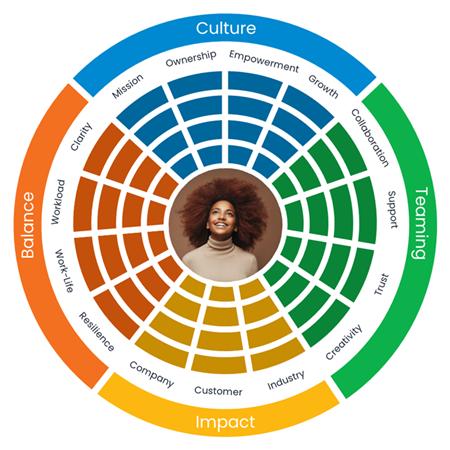The Future of Employee Performance: Our Human-Centric Growth Framework
In our recent article, The Future of Productivity: Human-Centric Performance, we delved into the limitations of traditional productivity metrics and highlighted the pressing need to shift towards a more human-centric approach. We discussed how conventional methods—focusing solely on tasks completed, deadlines met, and hours logged—fail to capture the full spectrum of human potential, often leading to false positives, burnout, and stagnation.
Today, we're excited to take this conversation further by introducing our Human-Centric Growth Framework. This framework operationalizes the previously discussed principles, providing a structured approach to redefine employee performance management in the "new normal." We aim to drive sustainable results for employees and organizations by placing people at the core of performance.
Revisiting the Need for a Human-Centric Approach
The Traditional Productivity Trap
As we highlighted, relying solely on quantitative metrics paints an incomplete picture of organizational health. For instance:
Surface-Level Success: Teams may meet deadlines but at the expense of quality and innovation.
Unseen Burnout: Employees might appear productive yet disengaged and on the brink of burnout.
False Positives: Traditional metrics can mask underlying issues, leading to misguided strategies.
The Human Element
Actual productivity encompasses more than just output; it involves:
Emotional Engagement: Fulfillment and passion drive creativity and commitment.
Intellectual Growth: Continuous learning fuels innovation and adaptability.
Holistic Wellbeing: Mental, physical, and emotional wellness are crucial to focus on for sustained performance.
Introducing the Human-Centric Growth Framework
Our framework is built on four foundational pillars that integrate the human element into every aspect of performance management:
1. Culture: Fostering Alignment and Empowerment
A strong culture that aligns individual motivations with company objectives is at the heart of any thriving organization.
Mission Alignment: Creating synergy between personal passions and organizational objectives to drive deeper engagement.
Ownership: Autonomy fosters creativity and responsibility.
Empowerment: Providing resources and support enables team members to contribute fully.
Growth Opportunities: Investing in skill development and career advancement helps employees reach their full potential.
Why It Matters: A culture that values alignment, ownership, and empowerment motivates employees and propels the organization toward collective success.
2. Balance: Promoting Holistic Wellbeing
Recognizing employees as whole individuals with lives beyond work is essential.
Clarity: Clear communication of roles and expectations prevents confusion and anxiety.
Workload Management: Ensuring tasks are manageable to avoid burnout and maintain high-quality output.
Work-Life Integration: Supporting a healthy balance leads to increased satisfaction and retention.
Resilience Building: Providing tools to manage stress enhances the ability to overcome challenges.
Why It Matters: Balanced employees are more productive, engaged, and capable of sustaining high performance over time.
3. Teaming: Enhancing Collaboration and Trust
Successful organizations thrive on effective teamwork and strong interpersonal relationships.
Collaboration: Promoting teamwork leads to shared success and innovation.
Supportive Leadership: Active involvement from leaders ensures that employees feel valued and guided.
Trust Culture: Creating a safe environment encourages openness and vulnerability without fear of negative consequences.
Creativity Encouragement: Supporting creative thinking fosters innovation and problem-solving.
Why It Matters: Strong teams amplify individual strengths and collectively drive the organization forward.
4. Impact: Making a Difference
Measuring success through the lens of broader impact inspires excellence.
Company Contribution: Recognizing how individual roles contribute to the bigger picture enhances purpose.
Customer Focus: Understanding and meeting customer needs drives satisfaction and loyalty.
Industry Engagement: Staying informed and contributing to industry trends keeps the organization competitive.
Why It Matters: An outward focus ensures relevance and adaptability in a rapidly changing landscape.
How Our Framework Addresses the Challenges Highlighted
Our previous discussion emphasized that more than simply layering human-centric strategies over traditional systems is needed. Our framework is designed to integrate these principles fundamentally, avoiding the pitfalls of surface-level fixes.
Integrated Systems: We move beyond task-based metrics by embedding human-centric values into everyday workflows.
Real-Time Insights: Leveraging technology to provide immediate feedback and support rather than relying on periodic surveys.
Authentic Engagement: Creating genuine opportunities for employees to share and address challenges.
Leadership Commitment: Encouraging leaders to adopt a mindset that prioritizes people over processes.
Embracing the New Normal with Our Platform
To support this transformative approach, we've developed a platform tailored to the Human-Centric Growth Framework:
Data-Informed Decision Making: Utilizing analytics to understand employee well-being and engagement in real-time.
Personalized Experiences: Offering individualized growth plans that are integrated into daily activities.
Collaborative Tools: Facilitating teamwork and communication, regardless of physical location.
Wellbeing Resources: Providing access to mental health support, stress management techniques, and more.
Leadership’s Role in Driving Change
As we noted, the shift towards human-centric performance begins with leadership:
Acknowledge the Gap: Recognize that traditional metrics are insufficient.
Embrace Vulnerability: Leaders must let go of control and trust their teams.
Create Accountability: Establish systems that reflect and reward human-centric values.
Commit to Growth: Engage in continuous learning and be open to evolving practices.
Why This Sets Us Apart
While many organizations are starting to recognize the importance of employee well-being, our approach is distinct:
Holistic Integration: We don't treat culture, balance, teaming, and impact as separate initiatives—they are interwoven into the fabric of our operations.
Employee-Centric Technology: Our platform is designed to support this framework, offering tools that empower employees and leaders.
Sustainable Change: Focusing on the human element drives long-term success and short-term gains.
The Time for Change Is Now
The future of work is undeniably human. Organizations that thrive will prioritize their people, not just in words but through actionable frameworks and dedicated resources.
What Does This Mean for You?
Join the Movement: Challenge traditional productivity norms and embrace a more holistic approach.
Lead by Example: Implement the Human-Centric Growth Framework within your teams.
Invest in the Right Tools: Utilize platforms and technologies that support this new paradigm.
Ready to Lead the Way?
We're excited to embark on this journey and invite you to join us in redefining what it means to succeed in today's dynamic business environment.
Stay Tuned: We'll be sharing more about how we're implementing this framework and its tangible benefits to our team and clients.

